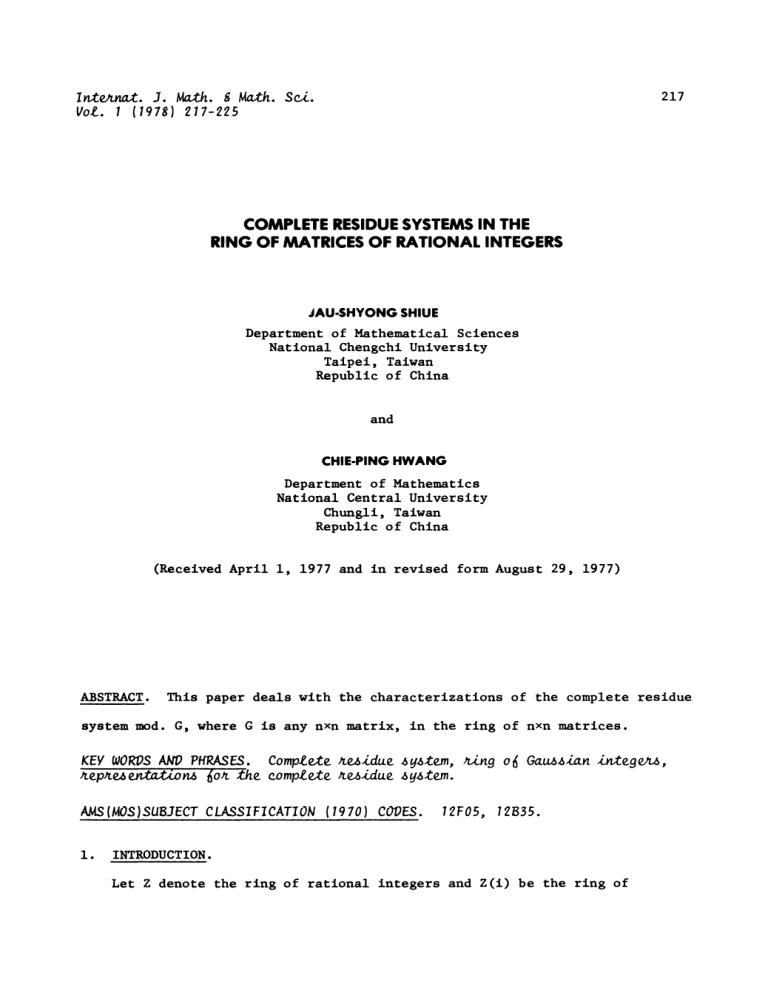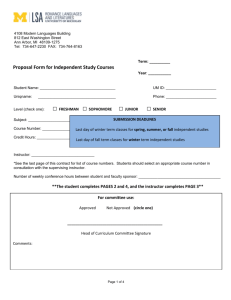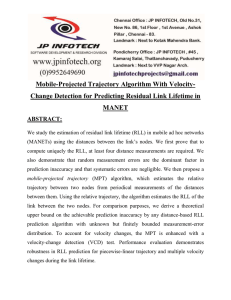a COMPLETE RESIDUE SYSTEMS IN THE OF MATRICES OF RATIONAL INTEGERS
advertisement

I ntrnat. J. Math. a Math. Sol.
Vol.
217
(1918) 217-225
COMPLETE RESIDUE SYSTEMS IN THE
RING OF MATRICES OF RATIONAL INTEGERS
JAU-SHYONG SHIUE
Department of Mathematical Sciences
National Chengchl University
Taipei, Talwan
Republic of China
and
CHIE-PING HWANG
Department of Mathematics
National Central University
Chungli, Taiwan
Republic of China
(Received April i, 1977 and in revised form August 29, 1977)
ABSTRACT.
This paper deals with the characterizations of the complete residue
system mod. G, where G is any nxn matrix, in the ring of nn matrices.
KEY WORDS AND PHRASES. Complete residue system, ring of Gasian integers,
the complete ridue system.
reprns for
AMS(MOS)SUBJECT CLASSIFICATION (1970) CODES.
i
12F05, 12B35.
INTRODUCTION.
Let Z denote the ring of rational integers and Z(i) be the ring of
J. S. SHIUE AND C. P. HWANG
218
Jordan and Potratz [i] have exhibited several representa-
Gausslan integers.
tlons for the complete residue system (in short, C.R.S.) mod.r, in the ring
of Gausslan integers.
Also it is well known that the ring of Gausslan
22
integers is isomorphic to the ring of
a, b in Z.
matrices of the form
-b
This raises the question of characterizing the C.R.S. mod.
a
G,
where G is any nn matrix, in the ring of nn matrices of which we denote by
Ma (Z).
n
2.
THE COMPLETE RESIDUE SYSTEM IN Mat (Z).
n
IB mean
UIA B.
First of all, we define A
and A
B mod. U means that
there is a matrix C such that B
CA,
Now we can give a definition of the
C.R.S. mod. U in the ring of Mat (Z).
0. Then a subset J of Mat (Z)
Let U be in Mat n (Z) with detU
n
is called a C.R.S. rood. U if and only if for any A in Mat (Z) there exists
DEFINITION.
n
uniquely a matrix B in J such that A
LEMMA i.
Eij
Ilk
Let
B mod. U.
dlag(gl,g2,...,gn)
G
with
gl # 0,
i
1,2,...,n.
Let
be "the matrix units, then
{aEZ
G
n
n
E
Y
m=i j--i
a
E
mj mj
where a
mj
in
Z,a il--ai2 --’’" =alk_l=0
are the principal ideals generated by a positive integer
aik--a}
gk’ where
i,k--l,2,...,n.
PROOF.
It is clear the
Ilk
are ideals in Z.
But Z is a P.I.D., therefore
Ilk are principal ideals generated by a positive integer dik. Since
Eik-- EikG n then gk is in Ilk, i.e., diklgk. On the other hand, for dik
n
Ilk we have m=i j=ir" amjEmj (tik)G for some (tik), where amj is in Z,
ail=ai2--...--aik_l--0, aik--dik. It follows that dik--tikgk, i.e., dlk Igkl
This completes the proof.
in
COMPLETE RESIDUE SYSTEMS IN THE RING OF MATRICES
LEMMA 2.
Let G
{(rlk)
J
0 <
dlag(gl,g2,...,gn)
rik
Igkl
<
with
gk # 0, k
219
1,2,...,n.
Then
i,k-- 1,2,...,n} forms a complete residue system
modo G.
PROOF.
that
A-
(i) For any A
’.Igkl
alk
Pik
(Plk
Igkl)
G
A-
0 <
Ir12 s121
+
r
lk’
(rlk)"
(alk)
in
Matn(Z),
where 0 < r
But
Igkl
there exist
Plk’ rlk
..Igkl.
Therefore
Elk-- Igkl
i EikG
ik
<
in Z such
and therefore
(rlk). This shows that A-- (rlk) mod. G.
(2) If (rlk) -= (Slk) rood. G, where 0 <
rlk Slk < Igkl then
G
(rik- Slk), i.e., rll Sll is in Iii (by Lemma i). This implies that
gl (rll Sll), and so rll Sll for 0 <_I rll Slll<Igl I- t follows
that
r12- s12 is in 112. Therefore g2 (r12 Sl2) and rl2 s12, for
<
[g21.
Continuing in this way, we must have
rlk-- Slk
for
all i,k-- 1,2,...,n.
THEOREM i.
If G is a nxn matrix with detG # 0, and if U and V are
unimodular nn matrices such that UGV
J
{(rik)V
-I
0
<_ rik
<
]gkl
i,k
diag(gl,g2,... ,gn),
1,2,...,n} forms
then
a complete residue
system rood. G.
PROOF.
follows
matrlx(rlk)
-1
(rlk)V mod. G.
Igkl such that AV-= (rlk)mod. UGV., i.e., A--I
Let (rlk)V-I
(Slk)V mod. G, where 0 < rlk Slk < Igkl.
that (rik)
(Slk)rood. UGV. Therefore (rlk)= (Slk).
with 0 <
(2)
(i) By Lemma 2, for any nxn matrix A, there exists a
rlk
<
COROLLARY i.
If J forms a C.R.S. rood. G, and U and V are unimodular nxn
matrices, then {URV
COROLLARY 2.
It
R in J} forms a C.R.S. mod. GV.
If G is a nxn matrix with detG
of the C.R.S. rood. G is
IdetGl n.
# 0,
then the cardinality
J. S. SHIUE AND C. P. HWANG
220
3.
THE COMPLETE RESIDUE SYSTEM IN Mat 2(z).
By restricting the order of the matrix we may relax the condition on the
diagonable matrix.
LEMMA 3.
Io
(i)
=o
I’
I u121
ull
u21 u22
Let U
{a e Z
U
{a
U
Z
I( a8 U)r
I 0a 0)6
e Mat
2(z)
for some =, 8, r e Z}
Ii=
Ii
{aeZ
U
{a e Z
U
I( 08 a)r
0
a positive integer
PROOF.
0
i
(i) a
Io
r
8
U
0
0
Moreover, I I
I
O
I’o illes U
U’
le
erefore d
d
Io,
o
Z and then
for some 6
o"
o"
o
for U
o"
0
detU
But Z is a P.I.D., therefore IO is an ideal
and then d
Since U
IU
lUll, dU21.
t21 t22
t21Ull + t22U21.
8.c.d.(Ull, U21).
0b 0)
Now detU e IO
is a nonzero ideal of Z.
UII, UI2
o"
i.e.,
0
generated by a positive integer d
we have
,
for some e, 8, r e Z, and then
"’
clear that IO is an ideal of Z
us
and
I I.
a8 S)r
implies U
0
b
Io I’.o
Moreover
} are nonzero principal ideals of Z generated by
a
the other hand, b e
and
g.c.d.(Ul,U2).
forsome 8, r e Z}
a
d
then
e Z} are nonzero principal ideals
for some
of Z generated by a positive integer d
(2)
# 0,
with detU
If
U
ilies U
By d
i
0
U
0
we have
e t 2(Z).
t21 t22
xlU21, then xld. us
for some
XlUll and
Io,
0
0
COMPLETE RESIDUE SYSTEMS IN THE RING OF MATRICES
(2) a e I
I
if b
b s
,
0
0
r
0
U such that
0
0
0
b
0
__u
and then I
U
I_ I I.
Conversely,
I 10 1
b
0
0
Now deU
d’ s
is an ideal of Z.
I1
_I
dedtU
0
Thus I
(0 i)(0
and so U
b
Z
then
r
and,
for some
i.e., a s I I.
It is also clear that
11.
a
a
(00J
then U
Ir
I( 0
U
I implies
221
i.e.,
11
for all
nonzero ideal of
I is a
Z.
But Z is a P.I.D., and then I I is an ideal generated by a positive integer
g.
Now
U
0
0
detU
detU
detU
a I implies
d s
d
I
0
g
det U
i.e.
gU21,
0
II,
g
-u21
y
d
g
we have
Ii,
gu21 gUll
Ull
gUll.
detU
t21Ull + t22U21
By the proof of (i), we have d
gd
IdetU
i.e., g
t21(gUll) + t22(gu21)
IdetU[
IdetUI
or
and then
g.
d
Therefore g
This
d
completes the proof of (2).
Let U
THEOREM 2.
d )=
g c
d.(Ull u21
r21
< d, 0 <
=/ ull
u12)
Then J
{R
Mat2(Z)
u21 u22
[
|
\
r12, r22
<
with detU
\
rl2j
r22
jr21
rll
# 0, let
Mat2(Z)
0 <
rll
is a complete residue system (rood. U) in
d
Mat2 (Z).
PROOF
r
(I)
From d
U
(1
d
Io,
II
d
0
U
we have
IdetUl
d
)
0
U
0
01
,i.e.,
J. S. SHIUE AND C. P. HWANG
222
there exists T i
Mat2(Z)
TIU,
d
r
1,2,3,4 such that
i
T2U,
)
a12
a21 a22
all
For any matrix A
that
Pll d + rll
all
for some
b12,b21,b22
PI2’ r12
Z, 0 <_
for some
0
<r21
d22
e Z.
A
PllTl
Finally
d22 P22
PIITI
P12T2u
U
rl r21 r2 r12
U
P12T2
P21T3
for some
P22T4
A
r21
<
for some
r12
P22,r22
P21,r21
)
e
)
--< r22’ r12
<
Mat 2(z) there exists R e
Assume that
<_ rll, r21,
Sll s21
rll r12
r21 r22
< d,
0
)
<_
i
sll s12
-= s21
s22
h
IdetU
<
d
r22
<
or
d
J2
(rood. U) where
r12 r22 s12 s22
e Z,
for some
Z, 0 <_
rl I r12
r21 r22
U
d, 0
c21 c22
R(mod. U).
(2)
0
r22
_< rll,
where 0
b21 b22
rll r12
r21 r22
U
such
PlI’ rll
rll
U
for some
r21
P21T3
U
+
d
U
+
d
PllTl
T4U.
d
PllTlU P12T2U
+
d
P21
c21
This proves that for any matrix
A
b12 PI2
Then A-
d
Again
Then A-
< d.
implies A-
U
Z.
c21,c22
<
Thus A-
O)
IdetU
0
there exists
< d.
Moreover,
Z.
r12
Mat2(Z)
<_ rll
where 0
T3U,
d
such that
COMPLETE RESIDUE SYSTEMS IN THE RING OF MATRICES
223
This implies
U
I
Now
r12-s121
rll-Sll
r21-s21
0 <
i.e.,
r12
e
rll
or
Ii,
rll
Io
Sll
or d
rll
Sll
rl2-Sl l
0
< d,
rll- Sll
r12- s12
so that
i e .,
r22-s22
It follows that
Sll.
(r12
’d
s12).
U
But 0 <
21-s21 r22-s 2
Ir12-s121
<
d
s12.
It follows that
U
i e
r21-s21 r22-s22
<_
Ir21-s211
r22
s22
Also 0
i.e.,
so that
r22
< d, so that
e I
COROLLARY 3.
or
IdetU
d
J2
(r22
Mat2(Z
e I
or d
o
(r21- s21)
This implies that U
s22).
Finally 0
<_
I I
sll s12
s21 s22
with detU
complete residue system (rood. U) is
REMARK.
)
are incongruent.
Let U e
s21
r21--s21.
rll r12
r21 r22
i.e.
s22
two elements in
I
r21
# 0.
Ir22-s221
r22-s22
<
IdetU
d
This proves that any
Then the cardinallty of the
detUl2.
If we consider the ring of 3x3 matrices, the corresponding
results will read as follows, the proofs will be as in Lemma 3 and Theorem 2,
with possible minor changes.
LEMMA 4.
Let u
I uij I
a
(i)
Io
{a e Z
U
el2
e21 22
31 =32
Mat3(Z>
with detU
el3h
for some
231
e33/
# 0.
eij
Then
e
Z},
224
J. S. SHIUE
0
I’0
{aeZ
U
I"0
{a
U
Z
C. P. HWAIqG
0
0
a
21 u22
31 u32 33
0
0
0
0
0
0
a
32 u33
Z}.
for some
eiJ
for some
32’ a33
t
Z}
are nonzero principal ideals of Z generated by the positive integer
go
g.c.d.
(Ull,U21,u31).
Moreover, I0
0
(2)
12
{a e Z
{a e Z
12
U
0
0
I0
a
21 22 23
u31 u32 33
U
I’
O
0
0
0
0
a
for some
iJ
e
Z},
for some
sij
e
Z),
31 32 33
{a e Z
12
U
0
0
0
0
0
0
01
are nonzero principal ideals of Z generated by the positive integer
where
g’
g.c.d.
(coful3 cofu23 cofu33),
g2
g’
cofulj
is the cofactor of the element
(3)
I
I
I
1
II--
{a e Z
{a
U
Z
U
{aZ
U
uij. Moreover,
21 a22 23
a31 a32 a33
/00
I
0
a
0
12 12 12
for some
aij
for some
iJ
for some
a33
0
23
u31 e32 33
0
and
a33
e Z}
COMPLETE RESIDUE SYSTEMS IN THE RING OF MATRICES
225
are nonzero principal ideals of Z generated by the positive integer
Moreover, I I
THEOREM 3.
II
I
gl
I.
Let U
Ull u12 u13
u21 u22 u23
Mat3(Z)
with detU
0, let
u31 u32 u33
go
g’c’d’(Ull’ u21’ u31)’ g’
J3
{R
[rij]
e
Mat3(Z)
g’c’d’(cful3’ cfu23’ cfu33)"
0 <
residue system (mod. U) where
rij
gl
<
g’
go
i,J
gJ-i
1,2,3}
Then
is a complete
detUl
g2
REFERENCE
I.
Jordan, J. H. and C. J. Potratz. Complete Residue Systems in the
Gaussian Integers, Math. Mag. 3__8 (1965) 1-12.





